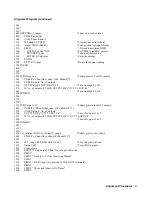
Remote Operation
82
Other Queries
In the examples discussed above, you saw how to use queries for each function discussed. The following paragraphs
describe other queries which were not previously covered.
ERROR Query
. The power supply can detect both programming and hardware errors. You can use either the front panel
(see page 89) or the GP-IB to find out the type of error. Upon detecting an error, the error annunciator on the front panel
and the ERR bit in the serial poll register will be set. When in local mode the supply will display the error name in response
to pressing the ERR key on the front panel. Over the GP-IB, only the error code will be returned. After a query, the error bit
is cleared. A description of these codes is given in Tables 5-8. To find out what the error is, send the following query and
address the supply to talk:
ERR?
The supply will respond with an error code number (see Table 5-8).
ID Query
. If you want to know the model number of the power supply you are working with, you can send the ID? query
over the GP-IB. To do this send the following over the GP-IB and address the supply to talk.
ID?
The supply will respond with its model number.
Test Query
. You can get the power supply to perform a limited self-test at any time during its operation by sending the
TEST? query over the GP-IB. This test does not affect the analog control circuits of the supply and it can be performed
while the outputs are connected to external circuits. For tests of the analog control circuits refer to Chapter 3. Responses to
the test query are described in Table 5-9. This test cannot be done from the front panel. To instruct the power supply to
carry out a self-test, send the following query and address the supply to talk:
TEST?
Calibration Mode Query
. To be able to calibrate your power supply, the calibration mode (CMODE) must be turned on
(See Appendix A for a detailed description of the calibration procedure). To find out if the CMODE is on or off, send the
following query over the GP-IB and address the supply to talk:
CMODE?
The supply will respond with a ’’1" which indicates that CMODE. is on or a "0" which indicates that CMODE is off.
DCPON.
The DCPON command sets the state of all outputs at power-on. You can specify if the outputs wake up enabled
or disabled when the unit is turned on. To enable all outputs at turn-on send:
DCPON 1
To disable all outputs at turn-on send:
DCPON 0
Note that these commands set the output voltage to zero and the output current to a slightly positive value when the
OUTPUT OFF command is issued. Therefore, the constant voltage feedback loop is active and the outputs are in constant
voltage mode when programmed “OFF”.
Starting with firmware revision A.00.04 and later, two additional commands let you set the output current to a slightly
negative value when the OUPUT OFF command is issued, causing the outputs to be in constant current mode when
programmed “OFF”. The benefit of being in constant current mode when the output is off is that if the load impedance and
the voltage and current settings are such that the unit is forced into constant current mode at turn on, then the current
feedback loop will be active during the transition to OUTPUT ON, and there will be no output current overshoot due to
mode crossover.
Summary of Contents for 6625A
Page 10: ......
Page 24: ......
Page 30: ......
Page 44: ......
Page 62: ......
Page 68: ...Remote Operation 68 Figure 5 2 Sheet 1 of 2 Syntax Forms For Power Supply Commands ...
Page 69: ...Remote Operation 69 Figure 5 2 Sheet 2 of 2 Syntax Forms For Power Supply Commands ...
Page 90: ......
Page 94: ...Alignment Procedures 94 Figure A 3 Figure A 4 Figure A 5 ...
Page 116: ......
Page 120: ......















































